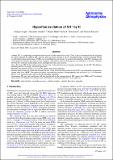Por favor, use este identificador para citar o enlazar a este item:
http://hdl.handle.net/10261/224407COMPARTIR / EXPORTAR:
 SHARE SHARE
 CORE
BASE CORE
BASE
|
|
| Visualizar otros formatos: MARC | Dublin Core | RDF | ORE | MODS | METS | DIDL | DATACITE | |

| Campo DC | Valor | Lengua/Idioma |
|---|---|---|
| dc.contributor.author | Lique, François | - |
| dc.contributor.author | Zanchet, Alexandre | - |
| dc.contributor.author | Bulut, N. | - |
| dc.contributor.author | Goicoechea, Javier R. | - |
| dc.contributor.author | Roncero, Octavio | - |
| dc.date.accessioned | 2020-12-04T10:50:13Z | - |
| dc.date.available | 2020-12-04T10:50:13Z | - |
| dc.date.issued | 2020-06-12 | - |
| dc.identifier | doi: 10.1051/0004-6361/202038041 | - |
| dc.identifier | issn: 1432-0746 | - |
| dc.identifier.citation | Astronomy and Astrophysics 638: A72 (2020) | - |
| dc.identifier.uri | http://hdl.handle.net/10261/224407 | - |
| dc.description | 5 pags., 3 figs. | - |
| dc.description.abstract | Context. SH+ is a surprisingly widespread molecular ion in diffuse interstellar clouds. There, it plays an important role by triggering the sulfur chemistry. In addition, SH+ emission lines have been detected at the UV-illuminated edges of dense molecular clouds, so-called photo-dissociation regions (PDRs), and toward high-mass protostars. An accurate determination of the SH+ abundance and of the physical conditions prevailing in these energetic environments relies on knowing the rate coefficients of inelastic collisions between SH+ molecules and hydrogen atoms, hydrogen molecules, and electrons. Aims. We derive SH+-H fine and hyperfine-resolved rate coefficients from recent quantum calculations for the SH+-H collisions, including inelastic, exchange, and reactive processes. Methods. The method we used is based on the infinite-order sudden approach. Results. State-to-state rate coefficients between the first 31 fine levels and 61 hyperfine levels of SH+ were obtained for temperatures ranging from 10 to 1000 K. Fine-structure resolved rate coefficients present a strong propensity rule in favor of Δj = ΔN transitions. The Δj = ΔF propensity rule is observed for the hyperfine transitions. Conclusions. The new rate coefficients will help significantly in the interpretation of SH+ spectra from PDRs and UV-irradiated shocks where the abundance of hydrogen atoms with respect to hydrogen molecules can be significant. | - |
| dc.description.sponsorship | We acknowledge the French-Spanish collaborative project PICS (Ref. PIC2017FR7). F. L. acknowledges financial support from the European Research Council (Consolidator Grant COLLEXISM, Grant agreement 811363), the Institut Universitaire de France and the Programme National “Physique et Chimie du Milieu Interstellaire” (PCMI) of CNRS/INSU with INC/INP co-funded by CEA and CNES. The research leading to these results has received funding from MICIU under grants No. FIS2017-83473-C2 and AYA2017-85111-P. N.B. acknowledges the computing facilities by TUBITAKTRUBA. This work was performed using HPC resources from GENCI-CINES (Grant A0070411036). | - |
| dc.language | eng | - |
| dc.publisher | Springer Nature | - |
| dc.relation | info:eu-repo/grantAgreement/EC/H2020/811363 | - |
| dc.relation | info:eu-repo/grantAgreement/AEI/Plan Estatal de Investigación Científica y Técnica y de Innovación 2017-2020/FIS2017-83473-C2 | - |
| dc.relation | info:eu-repo/grantAgreement/AEI/Plan Estatal de Investigación Científica y Técnica y de Innovación 2017-2020/AYA2017-85111-P | - |
| dc.relation.isversionof | Publisher's version | - |
| dc.rights | openAccess | - |
| dc.subject | Molecular data | - |
| dc.subject | Molecular processes | - |
| dc.subject | Radiative transfer | - |
| dc.subject | Methods: laboratory: molecular | - |
| dc.title | Hyperfine excitation of SH+by H | - |
| dc.type | artículo | - |
| dc.identifier.doi | 10.1051/0004-6361/202038041 | - |
| dc.relation.publisherversion | http://dx.doi.org/10.1051/0004-6361/202038041 | - |
| dc.date.updated | 2020-12-04T10:50:14Z | - |
| dc.contributor.funder | European Commission | - |
| dc.contributor.funder | Institut Universitaire de France | - |
| dc.contributor.funder | Centre National de la Recherche Scientifique (France) | - |
| dc.contributor.funder | Ministerio de Ciencia, Innovación y Universidades (España) | - |
| dc.contributor.funder | Grand Équipement National de Calcul Intensif (France) | - |
| dc.relation.csic | Sí | - |
| dc.identifier.funder | http://dx.doi.org/10.13039/501100004795 | es_ES |
| dc.identifier.funder | http://dx.doi.org/10.13039/501100004794 | es_ES |
| dc.identifier.funder | http://dx.doi.org/10.13039/501100000780 | es_ES |
| dc.identifier.funder | http://dx.doi.org/10.13039/501100010190 | es_ES |
| dc.type.coar | http://purl.org/coar/resource_type/c_6501 | es_ES |
| item.cerifentitytype | Publications | - |
| item.openairecristype | http://purl.org/coar/resource_type/c_18cf | - |
| item.grantfulltext | open | - |
| item.fulltext | With Fulltext | - |
| item.openairetype | artículo | - |
| Aparece en las colecciones: | (CFMAC-IFF) Artículos | |
Ficheros en este ítem:
| Fichero | Descripción | Tamaño | Formato | |
|---|---|---|---|---|
| Hyperfine excitation.pdf | 215,77 kB | Adobe PDF |  Visualizar/Abrir |
CORE Recommender
SCOPUSTM
Citations
8
checked on 14-may-2024
WEB OF SCIENCETM
Citations
6
checked on 25-feb-2024
Page view(s)
64
checked on 16-may-2024
Download(s)
85
checked on 16-may-2024
Google ScholarTM
Check
Altmetric
Altmetric
NOTA: Los ítems de Digital.CSIC están protegidos por copyright, con todos los derechos reservados, a menos que se indique lo contrario.
